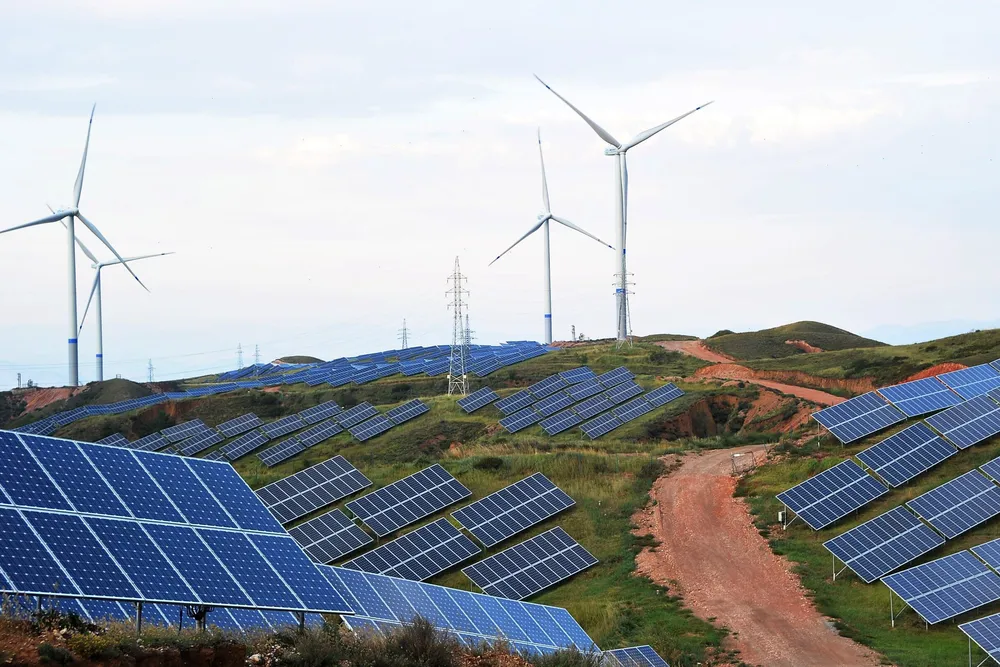Trump anti-wind onslaught cannot stop China's global energy transition train: DNV
Leading study describes how China is driving the global transition, but Trump onslaught has a cost

The Oslo-based classification and risk management firm found that non-fossil fuels will get close to an equal share of the world's primary energy mix by 2050, showing little change from the last such report.
Solar power and wind are expected to enjoy the strongest growth and will together occupy 32% of the global electricity mix by 2030.
Nowhere is the delivery of cheap renewable electrons more evident than in China, where decarbonisation of the domestic economy is taking place on a massive scale, coupled with low-cost electro-technology exports to other regions.
China is expected to add 390GW of solar PV this year – accounting for 56% of global installations – and will also add 86GW of wind power, or 60% of the global total, the report found.
Resurgent wind
This was a result of cost inflation but also "bans and freezes" on offshore wind projects in North America, with knock-on effects terms of the costs of offshore wind costs and the development of technologies.
Nevertheless, additions to offshore wind capacity are still expected to reach 100GW per year by 2030, rising to almost 250GW per year in 2040.
DNV said offshore wind will see a resurgence of installations by 2030, helping renewables to reach 50% of the total electricity mix by 2040.
Among the drivers of new growth, DNV expects wind uptake to grow quickly in the Indian subcontinent.
By 2060, DNV said wind will account for 32% of global electricity generation, the second largest share of any energy source.
Total global wind power capacity is slated to more than triple from 1TW today to 3.3TW in 2040 and is expected to triple again to 9.9TW in 2060.
Chinese turbine dilemma
Floating offshore wind is not expected to scale up properly until the 2040s as the technology, like green hydrogen is stuck on "the expensive side of decarbonisation, with uptake driven by policy rather than market forces”.
The current global average levelised cost of energy (LCOE) for floating offshore wind was stated at $390/MWh — almost three times as much as the LCOE for fixed offshore wind.
For the cost of floating wind to approach that of fixed, DNV said strategic policy interventions are needed to support uptake and accelerate technological advancement, standardisation in design and production and economies of scale, DNV said.
The commercial fate of floating wind is also likely to depend to a significant degree on a future role for Chinese wind turbines in key markets, the report implied.
While describing turbine costs in Greater China (including Taiwan) as "grossly underestimated" due to "extreme domestic competition and production overcapacity", DNV predicted that the LCOE for fixed offshore wind in Europe is likely to fall until it reaches parity with China in the late 2030s, with a similar but slower trend expected in floating offshore wind.
"When we model cost declines in the various regions, we see a faster decline in Europe than we see in China," said Sverre Alvik, energy transition director at DNV.
While this may be a natural consequence of the fact that China has already shed costs, while Europe is yet to do so, Alvik added that the projected decline also reflected DNV's belief that there will be an inroad of Chinese turbine installations into Europe over the coming years, contributing to that decline in costs.
"Globally, there are 30,000 fixed offshore wind turbines and there is only 30 floating offshore wind turbines," he said.
"These two technologies are at a very different stage of maturity and advancement in the one helps the other. It's a question on whether you want to embrace Chinese technologies a lot or not for the wind turbines.
Alvik admitted that this presented a "dilemma" for Europe.
'Pleasantly surprised'
DNV acknowledged that President Trump’s policy reversals on renewables and his support for fossil fuels will have impacts in a country that still accounts for one seventh of global primary energy use.
The administration's regulatory assault on offshore wind projects and its withdrawal from the Paris Climate Agreement are expected to delay US emission reductions by about five years, DNV forecast.
But this reversal was more than outweighed in global terms by the strength of growth from China and its clean tech exports.
"I must admit that I was positively surprised that the policy reversal we see in the US is having so little effect on the pace of the global transition," said Alvik.
"We see that the Chinese export of clean technologies is more important than the influence of American politics for the rest of the world."
Energy security
“Security has become the dominant driver of energy policy, and as our forecast shows, this is in sum accelerating the shift to renewables,” said Eriksen.
But DNV extended its Energy Transition Outlook from 2050 to 2060 because the firm does not expect the transition to be anywhere complete by 2050.
Although the energy transition is moving along inexorably, progress was described as far too slow to mitigate "grave risks for future generations".
(Copyright)